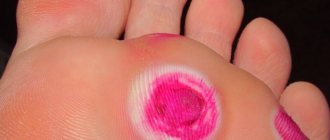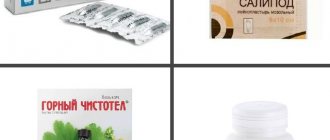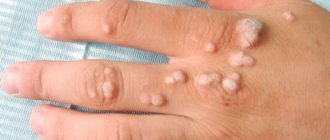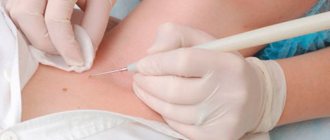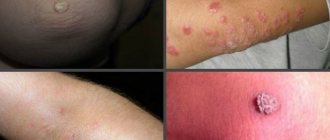05/24/2018 Many people who discover a spot under their nail begin to search on the Internet to find out what it could be? And it turns out that this can be a fatal disease - subungual melanoma.
In this article we will look at:
- concept of subungual melanoma;
- the chances of this type of tumor occurring;
- photos of symptoms with histological confirmation;
- ways to distinguish subungual melanoma from hematoma;
- procedures to clarify the diagnosis;
- prognosis and treatment.
Periungual warts: photos and general information
To begin with, it is worth familiarizing yourself with general information about pathology. A periungual wart is a benign neoplasm, the appearance of which is associated with a pathological proliferation of epithelial cells. The papilloma virus can affect the skin around the nails of both the fingers and toes.
Warts look like small round lumps, the surface of which rises slightly above the surface layer of the skin. Often the neoplasm tissue becomes horny and begins to peel off. Sometimes small cracks or wounds appear on the skin. The wart itself is painless. The appearance of such neoplasms is not accompanied by physical discomfort, itching, burning or other unpleasant sensations.
What does subungual melanoma look like? Photos and signs.
All pictures below are histologically confirmed and not taken from the Internet. The source is indicated in square brackets. There are 2 most common signs:
Sign I
Most often, subungual melanoma appears as a brown or black stripe. The strip starts from the nail fold and ends at the edge of the nail. This condition is called longitudinal melanonychia. Some medications can cause such bands to appear - retinoids and Docetaxel (Taxotere) [10]. This sign can also occur in conditions not associated with melanoma, for example, with fungal infection of the nail, pigmented nevus of the nail bed.
Subungual pigmented nevus in a 13-year-old boy [9]
Subungual melanoma stage I, 0.2 mm according to Breslow [10]
Sign II
The most common sign of this type of melanoma is Hutchinson's sign - a transition of pigmentation to the nail fold or fingertip. This feature is visible in 7 of the 8 images below. At the same time, it cannot be stated unequivocally that this symptom occurs only with melanoma. It can also be observed with a transparent cuticle [10].
8 cases of subungual melanomas in situ (initial stage) [6]
Subungual melanoma of the thumb with level 4 invasion according to Clark, thickness according to Breslow is not specified [8]
Subungual melanoma, Breslow thickness 1.5 mm [7]
Why do warts appear?
The appearance of warts on the skin (including periungual warts) is associated with activation of the human papillomavirus. There are more than a hundred varieties of the virus that can infect the human body.
Activation of the virus causes proliferation and rapid growth of cells - this is how a wart appears. The pathogen can enter the body through scratches, wounds and abrasions on the skin. In addition, the virus is transmitted from an infected person to a healthy person during sexual intercourse. A child can catch an infection from the mother during fetal development or during the passage of the birth canal.
Are there risk factors?
Statistics show that millions of people are carriers of the human papillomavirus. But the penetration of infection into the body does not always end with the formation of skin growths. The number of viral particles is strictly controlled by the immune system. A decrease in the activity of the body's defenses leads to an acceleration of the reproduction processes of the virus. Risk factors include weakened immunity, which is observed, for example, in acute and chronic inflammatory processes, immunodeficiency states, etc.
There are other risk factors to be aware of:
- Infection of tissues and the formation of periungual warts are often the result of improperly performed manicure and the use of unsterile instruments during the procedure.
- Risk factors include failure to comply with personal hygiene rules. This point is especially relevant when it comes to toenails.
- The habit of biting your fingernails or the skin around the nail plate also increases the risk of infection.
- You can catch the virus while visiting public baths, saunas, swimming pools, and showers.
- The infection is transmitted by sharing towels, nail files, nail scissors, and other items.
- Risk factors also include constant contact of the skin of the hands (or feet) with chemically aggressive substances. For example, in some industries, workers constantly work with various skin irritants, which increases the risk of skin damage and, accordingly, infection.
Symptoms and types
Depending on the location, nail growths are divided into two types:
Periungual
Appear on the skin near the nail plate. At the initial stage of its development, the formation of a small growth of flesh-colored or gray color with a rough surface is noted.
Most often, these neoplasms have a flat surface, but in some cases they can be elevated. Warts are similar to calluses, but their surface is looser. Due to systematic damage, the growths acquire a brown or red color;
Subungual
They are localized directly under the nail plate itself and do not manifest themselves in any way for a long period. Visually, the seals are pinkish or flesh-colored growths of a rounded shape.
As they grow, they lift the nail plate and thereby deform it. The appearance of transverse and longitudinal stripes on the nail is also noted, it becomes depleted and becomes brittle.
A distinctive feature of subungual warts from other types is discomfort and pain, which intensify as the tumor increases in size. If the growth is localized on the leg, the patient cannot wear usual shoes, since the wart is injured and inflamed, and as a result, bacteria enter the body.
Why can our articles be trusted?
We make health information clear, accessible and relevant.
- All articles are checked by practicing doctors.
- We take scientific literature and the latest research as a basis.
- We publish detailed articles that answer all questions.
When the growths become inflamed, their intensive growth and fusion are noted. Often the development of such neoplasms is accompanied by a fungal infection.
Why are warts dangerous? Possible complications
How dangerous can a periungual wart be? Reviews indicate that in most cases such growths represent only a small cosmetic defect. However, the likelihood of complications cannot be ignored.
- There is a possibility of existing tumors growing and new ones appearing.
- The growth of warts can lead to deformation of the nail plate. In the absence of therapy, nails become brittle, embossed, and begin to flake.
- Periungual warts are often injured. Small wounds and cracks form on the skin, which can turn into gateways for infection. Often the situation is complicated by the development of various bacterial and fungal skin diseases (especially when it comes to warts on human feet).
- As already mentioned, some types of papillomavirus increase the likelihood of skin cancer. That is why you should not refuse tests recommended by your doctor.
How to distinguish subungual melanoma from everything else?
Here is a fairly simple algorithm.
Algorithm for the differential diagnosis of benign melanonychia and the same condition in melanoma [8]
ABCDEF rule for diagnosing nail bed melanoma
And (age) age - the peak incidence of subungual melanoma occurs between the ages of 50 and 70 years, and also denotes races with an increased risk: Asians, Africans - they account for 1/3 of all melanoma cases.
B (brown to black) – the color is brown and black, with a stripe width of more than 3 mm and blurry boundaries.
C (change) – change in the color of the nail plate or no change after treatment. D (digit) – finger as the most common site of injury.
E (extension) - spread of pigmentation to the nail fold or fingertip (Hutchinson's symptom).
F (Family) – relatives or the patient have a history of melanoma or dysplastic nevus syndrome. [eleven]
How to distinguish a hematoma from a subungual melanoma by dermatoscopy
Hematoma: [10]
- It moves under the nail along with its growth. You can track this by taking a photo of the formation against the background of a ruler located longitudinally. It is important to note that a hematoma does not always appear due to trauma.
- Color from red-blue to black-blue.
- Does not transfer to the cuticle, nail fold and fingertip.
- Does not involve the entire nail in the longitudinal direction.
- May change within a few weeks.
- The color intensity decreases from the center to the periphery.
- It may be preceded by trauma.
- Small blood spots oriented towards the edge of the nail on dermatoscopy
Subungual melanoma: [12]
- Heterogeneous color, irregular stripes with melanonychia.
- Triangular stripes.
- Spreads on the nail plate, free edge of the nail or fingertip.
- Destruction or dystrophy of the nail.
Diagnostic measures
Diagnosis is rarely difficult. As a rule, a standard external examination is sufficient to confirm the presence of periungual warts. However, sometimes the doctor refers the patient for additional tests. For example, blood tests are sometimes done to help determine the strain of the human papillomavirus. Sometimes a tissue biopsy with further histological examination is necessary - this procedure is prescribed if there is a suspicion of a malignant process.
Treatment
A wart, regardless of location, is a benign formation that extremely rarely mutates into melanoma. If it does not cause discomfort and does not spoil the aesthetic appearance, then no therapeutic measures are taken. Treatment is necessary in the following cases:
Self-medication is dangerous with complications!
Attention
Despite the fact that our articles are based on trusted sources and have been tested by practicing doctors, the same symptoms can be signs of different diseases, and the disease may not proceed according to the textbook.
Pros of seeing a doctor:
- Only a specialist will prescribe suitable medications.
- Recovery will be easier and faster.
- The doctor will monitor the course of the disease and help avoid complications.
find a doctor
Do not try to treat yourself - consult a specialist.
- the boundaries of the growth become blurred;
- an increase in the number of neoplasms;
- modification of the wart (color or shape);
- bleeding;
- itching or pain.
There are several methods for removing warts.
Electrocoagulation
Pathological tissues are cauterized under the influence of alternating current. For this purpose, an electrode is used that is heated to a high temperature. Due to protein coagulation, the growth dies. After a short time, the skin at the site of the tumor is restored.
This method also has a number of contraindications, including active herpes, exacerbation of chronic diseases, cancer and all inflammatory processes.
Laser therapy
In this case, the pathological tissues are evaporated, and due to the instant sealing of the vessels, the risk of bleeding is completely eliminated.
The area of epithelium treated with laser quickly regenerates, and scars do not form. It is highly not recommended to remove growths using this method for patients suffering from diabetes, cancer and epilepsy.
The procedure is contraindicated for pregnant women and women during lactation, as well as in the presence of infectious and inflammatory diseases in the active stage.
Cryotherapy
Warts are frozen under the influence of liquid nitrogen. A bubble appears in the affected area, in the place of which the skin quickly recovers.
Large growths are removed in several sessions. The procedure is painful. That is why it is not used in the treatment of children. In addition, scar formation cannot be ruled out.
Excision with a scalpel
The operation is performed under local anesthesia. The method is used extremely rarely, only in cases where other therapeutic measures have failed and there is a suspicion that the growth has degenerated into a malignant tumor.
After this procedure, material remains for subsequent histological examination. There is a high chance of developing noticeable scars.
Drugs
In the early stages, warts can also be removed with the help of medications. The following groups of drugs are used:
- Keratolytics - the active ingredient in this case is salicylic or lactic acid, which helps dissolve keratinized areas of the epithelium.
- Preparations with local necrotizing effect.
- Antiviral local agents.
Among the effective means that can remove warts near and under nails are ointments, patches and solutions based on salicylic acid.
Therapy must necessarily include not only the use of external agents, but also the use of antiviral and immunostimulating drugs.
Any medications must be prescribed by the attending physician. Self-medication in this case is unacceptable. Warts can not only reappear, but also degenerate into a malignant formation. There is also a risk of secondary infection entering the body.
How to treat periungual warts? Features of drug therapy
It is immediately worth noting that drug therapy is rarely required. In most cases, it is enough to remove the wart, and sometimes the tumors completely disappear on their own.
Drug treatment of periungual warts is prescribed only if there is a marked decrease in the activity of the immune system. It is advisable to take Acyclovir and other antiviral drugs.
Naturally, treatment must be comprehensive. Antiviral drugs are taken not only internally - the affected areas of the skin are treated with special ointments and gels, which also negatively affect the activity of viruses. Products such as Panavir and Viferon are considered effective.
Treatment with pharmaceutical drugs
Traditional medicine offers several treatments for periungual warts. They are usually divided into two groups - conservative treatment and surgical intervention.
Conservative therapy refers to the prescription of medications that fight HPV and help improve immunity.
Usually these are medications for oral administration. The most effective of them:
- Cycloferon
- Anaferon
- Isoprinosine
You should not take these medications for self-medication. Only a specialist can prescribe them based on the clinical picture of the disease. In some cases, dermatologists recommend topical treatment.
Products for external use are prescribed depending on how many warts appear, what their size is and where they are located.
The list of the most effective medications for external use includes:
- Imiquimod (from RUB 2,019) is an immunomodulator.
- Solcoderm (price varies from 401 to 1,489 rubles)
- Verrukacid (from 211 rubles) - acid-based medications that promote tissue necrosis.
- Viferon (from 123 rubles) - antiviral ointment.
- Cryopharma (from RUB 859) is a refrigerant that freezes warts.
- Salicylic acid (price from 6 rub.)
- Collomak (cost ranges from 264 to 490 rubles) - keratolytic agents that destroy the stratum corneum of papilloma.
The doctor prescribes all of the above medications for the treatment of small periungual warts that are located on the surface of the skin.
If the papilloma is large, has a deep root or is an old formation, then it is recommended to resort to surgery.
Removing warts using chemicals
Periungual warts can be removed by exposing the tissue to chemically aggressive substances. There are a large number of drugs that can be purchased at the pharmacy:
- "Feresol" is a solution that contains metacresol. The drug is carefully applied to the wart. If the tumor is small, then one application is enough. Otherwise, the procedure will have to be repeated in a week.
- “Supercleaner” is also considered effective. The solution contains potassium and sodium alkalis, which cause tissue necrosis. The wart cells die and then begin to peel off. It is very important not to allow the solution to come into contact with healthy tissue areas.
- Some experts recommend Solcoderm solution. This drug contains a complex of acids that cause tissue necrosis.
Of course, you should not use such medications on your own; first, you should definitely consult with a specialist.
Surgical removal
A periungual wart can be removed surgically. In this case, the surgeon uses a scalpel to excise the tissue of the benign tumor. If necessary, the removed structures are sent for histological analysis to the laboratory.
It is worth noting that this technique is rarely practiced in modern medicine. The fact is that a scar often forms on the treated area. In addition, after the operation the wound heals for quite a long time. There is a high risk of tissue infection with the development of bacterial and fungal complications.
Diagnostics
Warts of this localization can be confused with other pathologies. Therefore, it is better to entrust the diagnosis and choice of therapeutic tactics to a doctor and not self-medicate.
For a competent dermatologist to make a diagnosis, it is enough to examine the skin formations. In some cases, additional research may be necessary.
Warts around the nails are very similar to calluses. The main difference between them is the preservation of the skin pattern on the surface of the calluses and the absence of thrombosed capillaries (black dots on the surface) in their structure upon visual inspection.
Warts under the nail cause its destruction, which is clinically very similar to a fungal infection (photos of these pathologies in the medical literature are practically the same). But a negative culture for fungi will quickly clarify the situation in terms of the etiology of the disease.
If necessary, the doctor will additionally prescribe a dermatoscopy and biopsy of the formation.
Cryodestruction: features of the technique
Cryotherapy today is one of the most popular and effective methods for removing periungual warts. The essence of the procedure is simple - pathologically altered tissues are treated with liquid nitrogen. When exposed to ultra-low temperatures, wart cells are destroyed.
After the procedure, a blister (burn) forms on the skin, which goes away on its own after a few days. This is an accessible technique, and its cost is relatively low. However, sometimes small scars remain on the treated areas of the skin.
Laser therapy
Laser removal of periungual warts is considered the most effective and safe method today. A concentrated laser beam removes overgrown wart cells layer by layer. In this case, there is no direct contact with human blood and tissue, and damaged vessels are immediately cauterized, which minimizes the likelihood of skin infection. By the way, during the procedure you can even remove those warts that are located directly under the nail plate.
As for the disadvantages, the list of them includes only the high cost of the procedure. In addition, not every hospital has equipment for laser removal.
What are the chances of this type of tumor occurring in a resident of Russia?
Of the total number of melanomas, the share of this tumor is only 2% [3], i.e., in absolute values, in 170 people per year. Against the background of the country's total population of 146,000,000, this, in my opinion, is very small. At the same time, a low incidence rate does not eliminate the possibility of getting sick.
For representatives of other skin phototypes other than 2, the chances may be very different. Representatives of the Mongoloid and Negroid races have a higher (up to 40%) chance of developing melanoma of the nail bed [4, 5].
Where does subungual melanoma appear most often?
The tumor most often affects the big toes [3].
Are there effective traditional treatment methods?
Of course, traditional medicine offers a huge number of medicines that can be prepared at home:
- Some traditional healers recommend treating the wart with fresh garlic juice.
- Do not forget about celandine - this is a universal way to combat skin warts. Cut the stem of a fresh plant and treat it with the juice of the new growth tissue.
- Kalanchoe can also be used to remove warts. A fresh leaf of the plant needs to be crushed, and the resulting pulp should be applied to the skin growth, securing everything on top with a plaster or bandage.
Features of subungual warts in children
Warts are more common in children than in adults. This is due to the immaturity of the immune system and frequent skin injuries. At the same time, self-resolution of such elements is also observed more often in them than in adults.
Most wart removal methods are quite painful. Therefore, parents of children are in no hurry to consult doctors, but resort to traditional medicine methods. This is not the best option.
There is little chance of getting rid of warts through self-medication, but it is quite possible to end up with deformation and destruction of the nail plate.
If a child has a single wart that does not bother him in any way, you don’t have to take any action, but just wait. There is a chance that it will disappear on its own.
But you should definitely see a doctor if:
- there are many warts;
- they grow;
- are injured and bleed;
- new elements continue to appear;
- There are doubts that this is a wart.
If any of these conditions occur, you should not put off visiting a dermatologist.
Prevention: Can warts be prevented?
Of course, it is much easier to try to prevent such tumors from occurring than to then worry about treatment. Prevention in this case is very simple:
- It is important to adhere to proper nutrition, take vitamins, exercise, strengthen the body, in a word, maintain the normal functioning of the immune system.
- Experts recommend adhering to the rules of personal hygiene, properly caring for nails, skin of hands and feet, and using appropriate soap and cream.
- It is very important to trim your nails correctly. If you are planning to get a manicure or pedicure, then choose only trusted professionals and be sure to ask for information about how they sterilize their instruments.
- Be sure to wear shoes that fit properly. Give preference to socks made from natural fabrics.
By following these rules, you can significantly reduce the risk of developing periungual warts.
